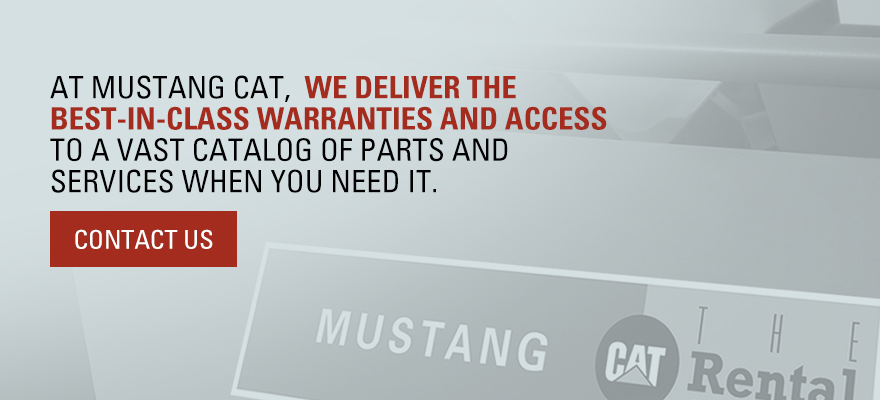How to Choose the Right Compact Equipment for Your Job
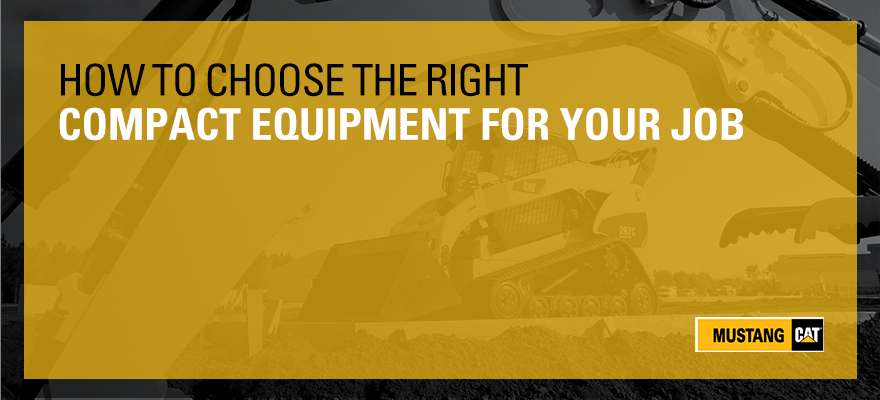
Working with the right equipment can make a difference in the outcome of your project, whether you’re constructing a house, forging a new front lawn or demolishing an old garage. Modern construction equipment helps you get the job done precisely and efficiently by delivering premium techniques that provide long-term benefits.
With so many options available to your construction, contracting or landscaping business, we know it can be challenging to determine the ideal machinery. Mustang Cat is here to guide you through the various tactics of selecting the right engine. We’ll also dive into the multiple uses of different compact equipment types to give you an idea of what matches your needs.
Tips for Picking the Right Construction Equipment
Cherry-picking the ideal piece of machinery out of dozens of options can be a tremendous task that’s both exciting and a little intimidating. After all, this massive investment could determine your business’ success.
When searching for small construction equipment for sale, you can follow six steps to ensure your purchase delivers what you’re searching for when it comes to efficiency, size, application and budget.
- Rely on the Experts at a Reputable Dealer
The best way to achieve a productive worksite is to rely on the experts. A leader in the compact equipment industry can recommend the best equipment size and the ideal make and model for your jobsite. When you depend on trusted expertise, you’ll receive the best deals on equipment and learn what machines best-suit your finances.
A reputable dealership offers transparent advice that will parallel your requirements and applications. Many also provide warranties and financial opportunities as they work with you one-on-one to determine your ideal solution.
2. Choose High-Quality Engines
Selecting heavy equipment also involves trusting a reputable manufacturer like Caterpillar®. It’s smart to be particular about the apparatus you choose because it can mean the difference in high levels of productivity that affect your bottom line.
Keep the equipment manufacturer parallel throughout your fleet. The same makes and models mean identical parts, repairs, setups, operations and more — which can save you time and add peace of mind. Investing in a top-tier, high–quality productdelivers proficient output in return.
3. Make Sure Spare Parts Are Available
Once you’ve ordered the best machine for your jobsite, repairs and maintenance are vital. After each use, the operator should inspect the equipment for damage, leaks, dents or other faulty components. Keeping up with regular maintenance and repair can sustain the engine’s operating capacities throughout the years and help you avoid downtime.
It’s essential to confirm the parts and services are available for your particular make and model before choosing a machine. Ensure your local dealer has everything necessary to support your equipment’s maintenance and repairs.
4. Understand Your Project Requirements
Knowing what you want to get out of your equipment is key to picking the best solution. Will you be digging, hauling, demolishing, landscaping or grading? The application at hand can help you determine whether you need a compact skid steer, excavator or another option.
Will you be working with materials such as gravel, stone, dirt, clay, concrete, mulch or sand? Understanding the environment will guide you in selecting a wheel versus a track loader. Also, consider the climate. Will your operators require an enclosed cab or snow attachments?
Other project requirements include short-term versus long-term use, the size of your task and your operators’ ability and experience.
5. Purchase Your Fleet in Stages
Invest in equipment according to what stage you’re at in the construction process. Buy as you go instead of procuring an engine you may not need. Order your equipment according to the flow and synchronization of your project.
Base your construction equipment’s size on the level of job you’re conducting. Too small or too large of a machine can hurt your operations and bottom line. A unit that’s not big enough means you’re losing efficiency, while one that’s too big means you’re wasting output, space and money. When purchasing an equipment fleet, it’s best to choose engines of the same or similar size, not ones that vary from compact to standard to large.
6. Consider Used or Rental Equipment
When you need heavy-duty machinery, you’ll find several worthy options besides buying new. Pre-owned engines are as useful and productive as new versions and offer reduced upfront cost. Your best bet is to partner with a reputable dealer that maintains, tests and repairs used machines to ensure optimum performance. Used equipment is also a tremendous option for new businesses or companies on a strict budget.
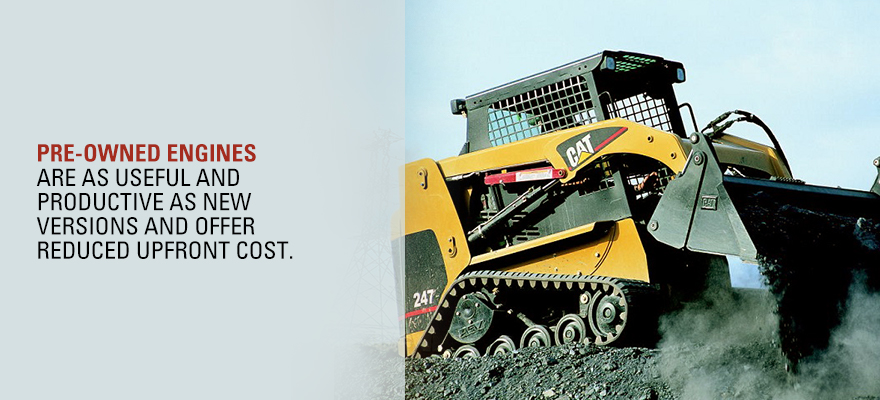
Is renting an option for your business? It’s the perfect solution for one-time jobs or specialized projects that require a machine outside your fleet’s capabilities.
When it comes to selecting compact construction equipment, it’s vital to have a game plan before hauling your new machine. The above tips on picking the right equipment and taking time to compare various sizes offer several advantages such as:
- Greater attachment compatibility
- Increased job safety
- Greater efficiency from the correct load capacity
- Less operating time
- No over- or under-loading
Down vs. Up Investing
Your choices are endless when selecting heavy equipment — from the rental provider, brand and equipment type to models, capacities, features and attachments. Each combination creates the perfect machine for dozens of jobs. A trustworthy dealer can help you find your ideal blend of features and avoid down- or up-investing in a unit.
- Equipment down-buying: Buying a machine that’s too small limits your capabilities on the jobsite. You might need more power and capacity than what you’ve bought, which can end up being a waste of money. Insufficient load or lift ability can hurt your productivity.
- Equipment up-buying: Similarly, avoid investing in equipment that’s too big for a task. You can pay too much for a size that doesn’t match your needs. Larger units are more challenging to operate and can’t maneuver in small areas when necessary.
What Is Compact Construction Equipment?
Determining whether you need a compact, medium or large piece of machinery is a significant consideration for any business. Every machine plays a different role in your fleet to boost productivity. While each size can perform the same duties, they do so at varying levels of proficiency.
The smallest machines to the largest all have standard hydraulics that delivers incredible productivity and high outputs in relation to the environment. However, compared to their larger counterparts, the smaller solutions have different operating weights, digging depths and digging reaches. They are ideal for smaller entranceways and exits and are perfect for maneuvering around tiny spaces and tight corners.
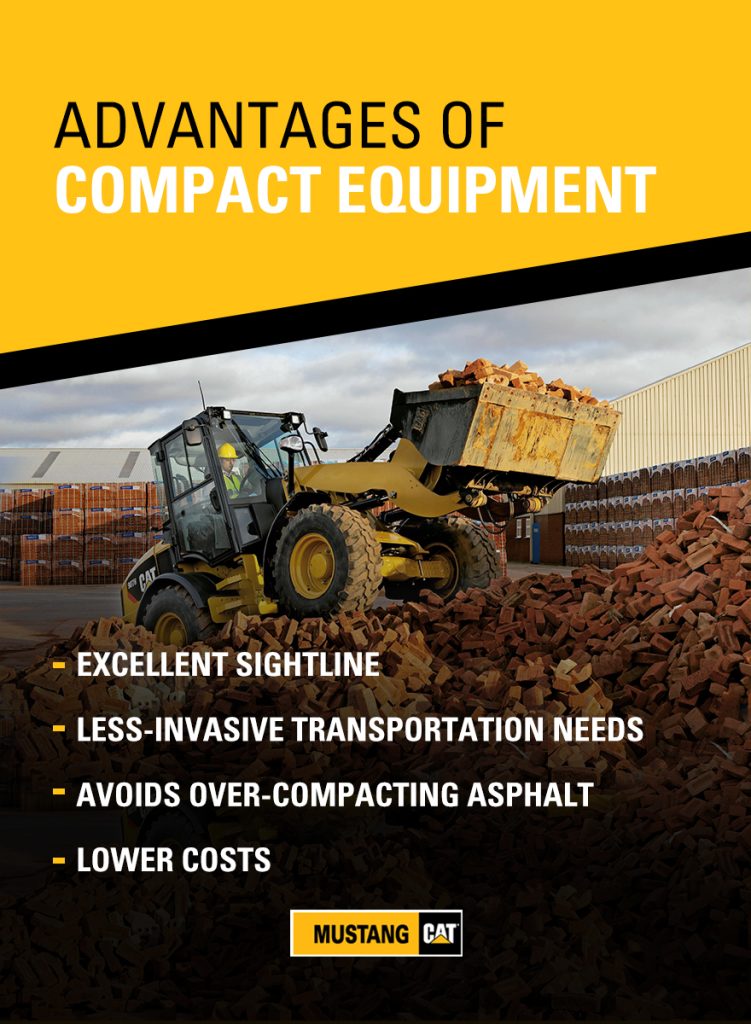
Compact machines have several on-the-job advantages that include
- Excellent sightline: A smaller unit allows the operator to perform closer to the project, which improves their work quality.
- Less-invasive transportation needs: In contrast to more significant engines, compact options require smaller trailers and trucks for transportation from the dealer or different worksites.
- Lower threat of over-compacting asphalt: When an oversized machine operates on the material, the pavement can drum and overlap. When asphalt compacts, it can cause erosion. Small machines lessen this threat.
- Lower costs: Small equipment also upholds a lower cost of ownership.
Compact units support construction, landscaping, contract and other businesses when you need maneuverable solutions that provide stable output levels.
Types of Compact Loaders: Uses and Applications
Referencing a compact construction equipment list can help you during the buying process. By understanding the variances between the four compact equipment options and how you can use them in the field, you can better relate their uses, attachments and benefits to your application.
What Is a Skid Steer?
A skid steer loader has a rigid frame with lift arms alongside the driver. The machine has four locked wheels that allow for incredible maneuverability. The left and right wheels, which operate independently from each other, move at varying speeds. Thus, the unit skids its wheels across the ground to shift — an action that can easily rip up the ground.
Working with a skid steer produces zero-radius turning, making it ideal for small movements. The unit can power various attachments such as snow accessories, trenchers and grapplers to conduct a range of tasks. They’re used to support landscaping, site developing and final grading, as well as for pushing, carrying and loading various materials.
Skids are simple to operate by producing turns within its footprint. They have a massive range of motion that requires minimal driving, making them among the most popular pieces of equipment. Consider a skid steer’s operating capacity, size and weight, terrain, attachments and lift type before buying.
What Is a Compact Track Loader?
Also known as multi-terrain loaders, compact track loaders have a tracked chassis for a smooth ride and versatile abilities. The unit can perform almost every job on a site, making it one of the most common pieces found in a fleet. The equipment has a low center of gravity for increased stability and suspended tracks that allow for better ground contact.
Operating a compact track loader is similar to working a skid steer. While the two machines are similar, the track loader operates with rotating tracks while a skid moves via wheels. The tracks allow the loader to perform on challenging surfaces such as mud, sand, rock, snow and turf.
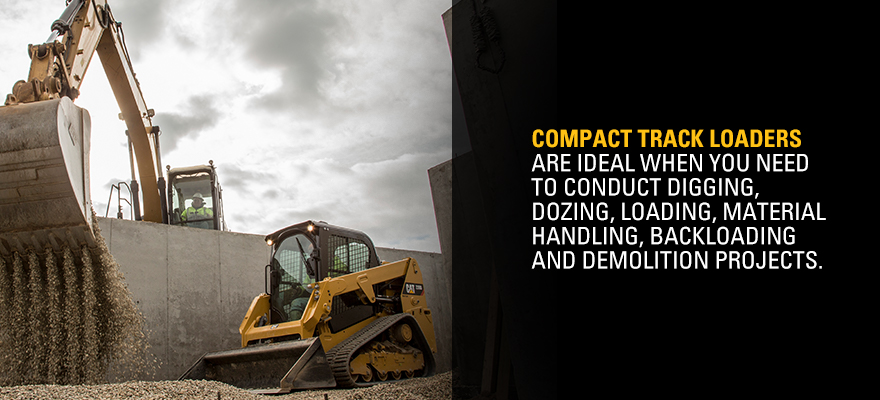
Track loaders can even withstand wet and uneven surfaces with more stability. The tracks glide over different ground types. However, the tracks require more maintenance and are prone to more wear on hard surfaces like concrete.
A compact track loader is ideal when you need to conduct digging, dozing, loading, material handling, backloading and demolition projects. Attachments like backhoes, trenchers, augers, blades, buckets and grapples are also perfect for landscaping, paving, land clearing and other sectors.
What Is a Compact Wheel Loader?
A compact wheel loader has a front-mounted bucket attached to two arms, giving it the freedom to scoop materials. Articulated steering provides great maneuverability. The earthmoving equipment is ideal for heavy lifting as well as loading and pushing loose materials like dirt, rock, snow, sand, gravel and clay.
While loaders can dig holes, they are not as efficient at digging as other tools because they cannot excavate deeper than their tire levels. Instead, wheel loaders are especially apt at transporting bricks, metal and pipes. Their wheels provide increased mobility and speed and cause little damage to their surroundings.
Compact wheel loaders are versatile for numerous industries like construction, material handling, forestry, mining, recycling and landscaping. Attachments include shovels, forklifts and grapples.
Choosing a compact wheel loader versus a skid steer can be tricky because of their overlapping uses — however, each is unique in its operations. The units have different maneuverability and articulation. A wheel loader uses a hydrostatic system and pivots between half of the rear and front axles to turn. In contrast, a skid steer has a zero-turning radius to help it fit in tight spaces.
Deciding between a compact skid steer and wheel loader depends on your application and available space. Skids are shorter and pivot well in confined sites, while wheel loaders do well in slightly bigger areas when you need higher ground clearance.
What Is a Mini Excavator?
The components of an excavator include a boom, dipper and bucket, with a cab that sits on a rotating platform. The undercarriage has either tracks or wheels. Hydraulics power the machine, while a left and right joystick move its various parts. The left device controls the left and right movements of the cab and bucket, while the right joystick tilts the bucket out and curls it to remove material.
Mini excavators are ideal for rough grading projects, digging trenches, demolition and material handling. Between mini, standard and large excavators, minis are the most mobile. A mini-unit is perfect for small jobs that involve tight space requirements and worksites where your workers need to maneuver around buildings and power lines. The machine needs the least amount of power to operate, as well. During operation, it creates minimal damage to sites, roads, yards and sidewalks.
Mini excavator attachments like hammers, buckets, rippers and couplers can form a more versatile piece of equipment. Before investing in an excavator, you will want to consider its power, size, weight and bucket capacity. Most minis weigh between 1 and 10 metric tons.
Count on Mustang Cat
Searching for the most compatible compact construction equipment for sale is simple when you count on the team of experts at Mustang Cat. Our experts will work with you to make sure your operations remain efficient and productive with top-tier compact units.
As a family-owned Cat® dealer, we deliver the best-in-class warranties and access to a vast catalog of parts and services when you need it. We also uphold industry-leading response times for service to ensure your worksites see minimal downtime.
Search for a Mustang Cat location near you, or contact our specialists to learn more about compact equipment and which machine best suits your business. We’ll provide you with expert advice and honest guidance to deliver a piece of equipment that matches your needs.
